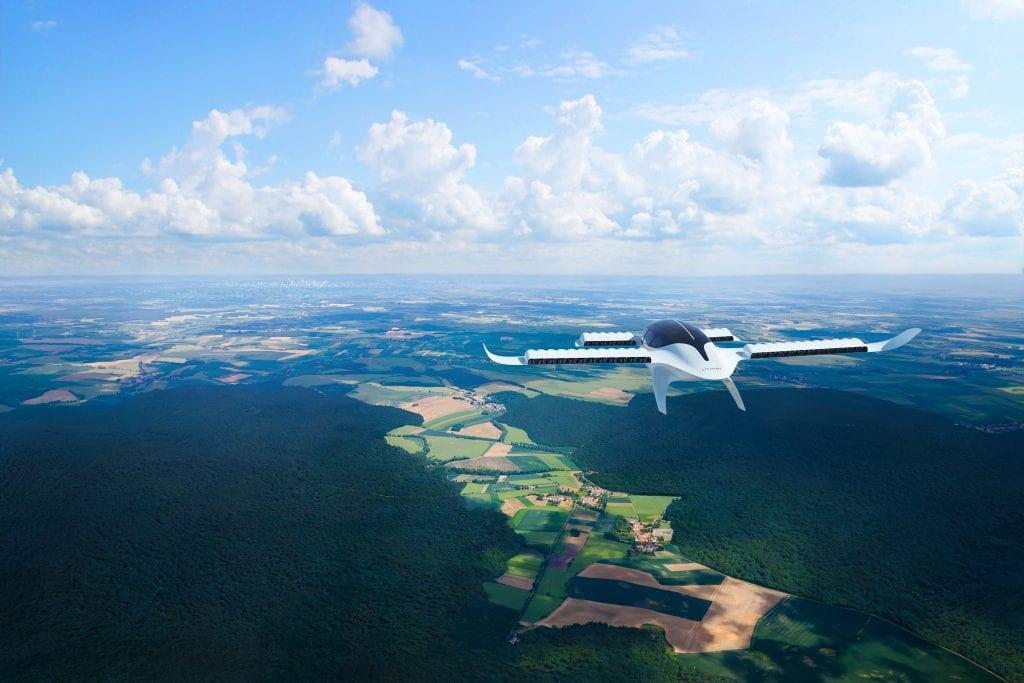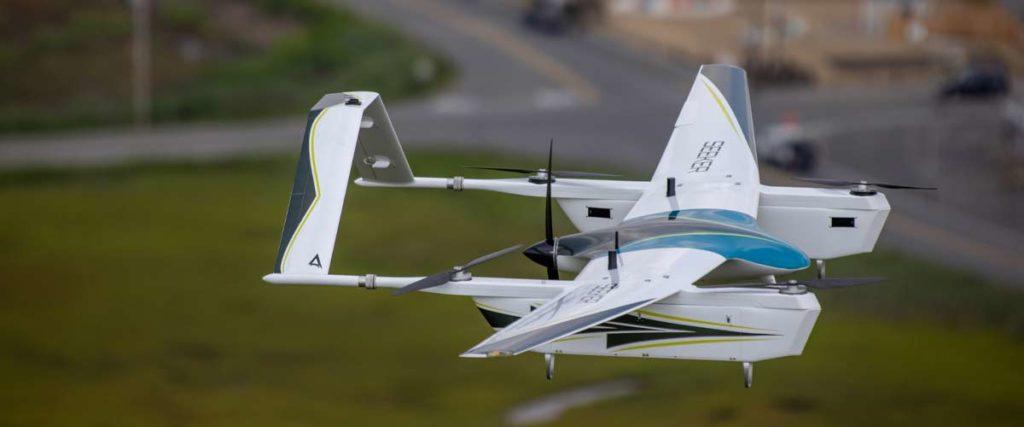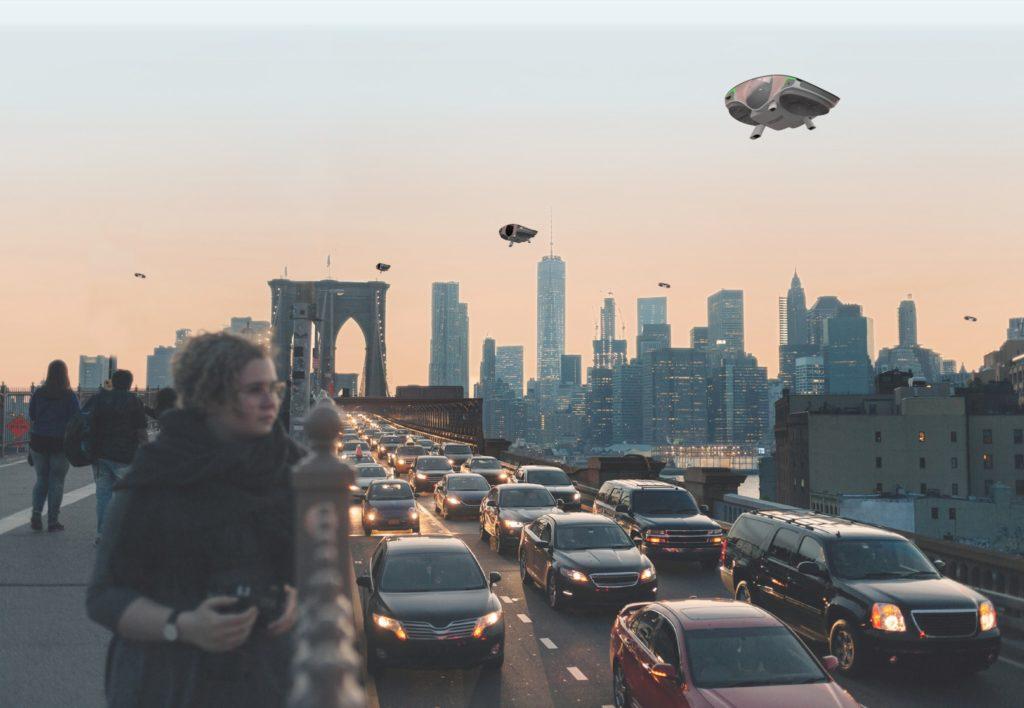An urban airplane, the Lilium Jet, with a view of Manhattan in the background.
When thinking about the future of urban mobility in cities, most of us might associate the term with electric cars, e-bike sharing, e-scooters and electric bus adoption for public transportation.
But advances in autonomous flight technology and 5G wireless communications networks along with the need to reduce carbon and decongest roads in densely populated cities have introduced the possibility of urban air mobility (UAM) — most often in the form of commercial passenger and logistics drone services in low-altitude airspace.
The increase in demand for an alternative mode of transportation in urban mobility is a key factor driving the anticipated growth of UAM — with one researcher projecting growth from $2.6 billion in 2020 to an estimated $9 billion by 2030. Other predictions are more bullish, suggesting the market could rise to $12.4 billion by 2027.
With about 200 companies involved in the development of electric vertical-takeoff-and-landing vehicles (eVOTL), UAM is increasingly seen as a future option for affordable, rapid and sustainable intercity travel, and some companies are looking to launch their services as early as the end of 2022.
There is also a demand for more efficient modes of logistics. For example, with the rise of e-commerce, companies such as Amazon and delivery fleets such as UPS, which won approval from the Federal Aviation Administration to operate a fleet of drones in 2019, there is a significant need for the use of operational based drones, for cargo delivery. But they can also be useful for public services such as crash incident scenes, emergency response and environmental monitoring.
Of course there are still challenges with these technologies. What’s more, FAA rules and regulations at the state level — such as the need to have a pilot’s license for any single passenger drone — could hinder commercialization.
Regardless whether we see a passenger drone in the next five years, the prospect is exciting. The ambition of these well-funded companies only proves the desire to advance the way society travels and operates in the logistics space. So while the general public waits for this technology to take off, let’s look at seven companies making headway and headlines in the eVOTL space.

Airbus
The European aerospace company unveiled a brand-new flying taxi called the CityAirbus NextGen in late September.
The fully electric, four-seat CityAirbus NextGen UAM aircraft has two goals — running quietly and covering short distances quickly. Ushering in the next generation of CityAirbus, the vehicle is equipped with fixed wings, a V-shaped tail and eight electrically powered propellers as part of its uniquely designed distributed propulsion system. It is designed to carry up to four passengers in a zero emissions flight.
Beyond the aircrafts, Airbus is working with other partners, cities and city inhabitants to create the services and infrastructure essential to enabling UAM to emerge as a real means of transportation.

Joby Aviation
Late last year, this secretive California-based electric air taxi developer announced its acquisition of Uber Elevate after a $75 million Investment from Uber Technologies.
The deal calls for the two companies to integrate their respective services to support the development of an eVOTL passenger aircraft that could take to the skies as early as 2023.
The investment supplements a previously undisclosed $50 million investment from Uber in January 2020 for Joby’s Series C financing round, according to a press release. As of the merger announcement, Joby Aviation’s total funding stood at $820 million.
And this February, Joby Aviation became the first eVOTL company to list publicly on the stock market through a special purpose acquisition corporation (SPAC) transaction.

Lilium
One company already considered a leader in the UAM travel industry is German electric aircraft developer Lilium. This Munich-based company is ready to launch regional air mobility vertiports in Bavaria using its seven-seat eVTOL Lilium Jet and in Orlando, Florida, with its five-seat eVOTL Lilium Jet.
The Bavaria-based vertiports will be built in Düsseldorf Airport and Cologne/Bonn Airport to position those two airports as hubs in a regional air mobility network spanning another German state, North Rhine-Westphalia.
Lilium’s Florida air mobility network is in partnership with the multinational infrastructure operator Ferrovial, which is set to build a hub in Orlando for an inter-city transportation network in the heart of tourism for the Sunshine State.
Ferrovial is a Spanish multinational company involved in the design, construction, financing, operation and maintenance of transport infrastructure and urban service.
The partnership hopes to become an option for the 50 million travelers who pass through the Orlando International Airport annually to travel on Tampa, St. Petersburg, Fort Lauderdale and Miami. The startup’s Lilium Jet — the five-passenger aircraft that travels at 186 miles per hour — will cut travel time between Orlando and Tampa to 30 minutes compared to a two-hour car ride.

Terrafugia
Not only did Terrafugia receive the FAA special light-sport Airworthiness Certificate for “Roadable Aircraft” in 2021, but it also launched a new brand with a new drone — the Commaris Seeker.
The Seeker is an electric, fixed-wing/VTOL hybrid aircraft designed for autonomous commercial aerial applications. It has a long-endurance capability of over three hours of flight time without a battery change, supports multiple payload configurations and travels at a top speed of over 60 miles per hour.
The drone has a large payload-carrying capability of up to 10 pounds. It will include a 30x optical zoom EO/IR camera for inspections, a 120-megapixel high-resolution camera for mapping, a six-band multispectral camera for precision agriculture, LiDAR systems, laser methane and corona discharge sensors — making it ideal for inspections of power lines, railways and maritime search and rescue.

Tetra
Tetra, the startup based in Tokyo, Japan, has begun developing commercially available personal eVTOL Mk-5 aircraft to start delivering in 2022. According to the company, it has already taken an unspecified number of orders, but customers will need a private pilot’s license, and each build will need to be inspected and registered by the FAA because it will be registered as homebuilt/experimental aircraft.
The Mk-5 is a lightweight personal machine for pilots less than 200 pounds; it places a slim cabin between two wide wings. The front and rear wings have a total of 16 propulsion pods attached, each with two vertical lift rotors fore and aft, making for a total of 32 lift fans for VTOL operation. A single cruise prop on the back enables cruise speeds up to 100 mph, and a 13.5 kilowatt-hour battery offers flight ranges up to 99.4 miles.
Tetra also released a video of a test flight taken in California, which shows the Mk-5 SN2 prototype flying unmanned.

Urban Aeronautics
Known as the developer of the world’s first compact, wingless eVTOL vehicle, Urban Aeronautics continues to push the limits. After a new investment, it continues to get closer to turning its groundbreaking concept into reality with its CityHawk aircraft.
Earlier this year, after a partnership with California-based Hypoint, Urban Aeronautics successfully conducted its first flight tests of the aircraft. The two companies also adapted fuel cell technology for the CityHawk, which is designed to be powered by hydrogen.
The CityHawk flying car integrates an innovative Fancraft-based vertical take-off and landing technology, with dual enclosed, ducted rotors, which increase stability and decrease noise significantly. The compact aircraft incorporates autonomous systems with the ability to detect and avoid traffic, power lines and other urban structures. The CityHawk is also able to operate safely at night and in all weather conditions.
Another benefit of its compact design is the ability to land on vertiports placed on building rooftops, which saves time and increases efficiency, especially in case of emergencies. Inside, it’s supposed to be as welcoming as a premium car, thanks to the comfortable seats, Wi-Fi and touchscreens.
The aerospace company’s next goal is to raise $100 million, in order to further develop the hydrogen-fueled Fancraft technology.

Volocopter
In mid-October, Volocopter took to the skies in Hamburg, Germany, with the first public test flight of its heavy-duty VoloDrone.
The three-minute milestone flight was undertaken with German logistics firm DB Schenker and took off from Hamburg’s homePORT innovation campus, reaching an altitude of 72 feet.
VoloDrone should create a more robust, efficient and sustainable for existing logistics processes. The drone uses 18 rotors, a battery and electric motors to hoist itself into the air, using a rail attachment system in between its landing gear to carry loads of up to 441 pounds over a 25-mile range.
Since launching the VoloDrone in 2019, Volocopter has carried out several flights in closed test areas around Germany. But its October flight was the first time the drone has operated in a public environment.

